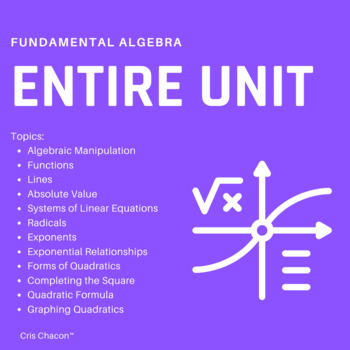08 - Forms of Quadratics Unit Bundle
- Google Docs™

Products in this Bundle (11)
showing 1-5 of 11 products
Also included in
- 36 conceptual algebra classwork assignments, 34 conceptual algebra guided notes, 16 quizzes, 11 unit reviews, 11 writing assignments, 11 unit tests, 11 unit plans, and 11 curriculum guides!Classworks:There are a variety of free response questions for most classworks, which are usually one to four paPrice $500.00Original Price $615.00Save $115.00
Description
3 conceptual algebra classwork assignments, 3 guided notes, 1 quiz, 1 unit review, 1 unit test, 1 writing assignment, and 1 curriculum guide!
Classworks:
There are a variety of free response questions for most classworks, which are usually one to four pages long. Classwork assignments are used for students to deploy skills developed from in-class discussion and direct instruction as a way to practice problem-solving en route to mastery of learning targets before quizzes and unit tests.
Guided Notes:
Most guided notes provide in-context examples of concepts that will be heavily referenced and utilized throughout the unit. Guided notes include scaffolded diagrams and highlight key concepts for students tofocus on.
Quizzes:
There is a mix of free response and short answer questions for most quizzes, which are usually one or two pages long. Quizzes are used for students to demonstrate proficiency of learning targets outlined in the corresponding curriculum guide by deploying skills utilized in problem-solving on classworks derived from class discussion and direct instruction. Quizzes are a good way for students to gauge their level of mastery to indicate how to study for unit tests.
Unit Reviews:
Unit reviews are usually 2 to 4 pages long and usually consist of a mix of conceptual short answer questions and free-response questions. Unit reviews are used for students to assess their current mastery of learning targets outlined in the corresponding curriculum guide derived from class discussions and direct instruction, utilized in problem-solving on classworks and assessed on quizzes. Unit reviews are a good way to review for the summative unit test and final exam assessments.
Tests:
There is a mix of free response and short answer questions for most tests, which are usually two to four pages long. Tests are used for students to demonstrate mastery of learning targets outlined in the corresponding curriculum guide by deploying skills derived from class discussion and direct instruction, utilized in problem-solving on classworks, and assessed on Quizzes. Unit Tests are summative assessments for teachers to gauge a student’s level of mastery to indicate how to study for final exams.
Writing Assignments:
These short writing assignments are usually one page long and include 3 to 5 short answer prompts that require students to explain and demonstrate their mastery of different learning targets covered in each unit. There is a rubric embedded at the bottom of each assignment as well for streamlined grading.
Curriculum Guides:
Each Curriculum Guide includes a Unit Overview document and a Student Self Assessment document. This is an excellent way to communicate to students what content will be covered in the unit, when it will be covered, and what learning targets they are expected to master.
The Unit Overview contains the following:
Front Page
- Topics covered
- Assessments (with tentative dates that you can modify)
- Document Order/List (useful for conducting quick and efficient binder checks)
Back Page
- Vocabulary (with an asterisk next to any key terms on an assessment)
- Diagrams, graphs, and other useful images
The Self Assessment contains the following:
Front Page
- A paragraph on the importance of reflection
- A rubric indicating how to assess understanding of each learning target
- A table with the set of learning targets covered throughout the unit (learning targets are also broken down by what assignments they appear on)
Back Page
- A rubric indicating how to assess preparation for each assessment, including quizzes and tests
- A space to write a plan for what students are going to do in order to study for that corresponding assessment
Learning Targets Assessed:
I know...
- the definition of a quadratic function and a parabola.
- the definition of an x-intercept, root, and zero and how to represent a solution to a quadratic function.
- the standard form of a quadratic function and the important data points that can be identified from it.
- the factored form of a quadratic function and the important data points that can be identified from it.
- the zero product property.
I can
- convert a quadratic function between standard form and factored form.
- factor a quadratic function in standard form by using the “box” method.
- factor a quadratic function in standard form by using the “ac table” method (factoring by grouping).
- factor a quadratic function using the difference of squares.
- factor a quadratic function when the lead coefficient is 1.
- factor a quadratic function when the lead coefficient is not 1.
- solve a quadratic function in factored form using the zero product property
Solutions are available by emailing cris.chacon@knowlesteachers.org after purchasing this bundle.



